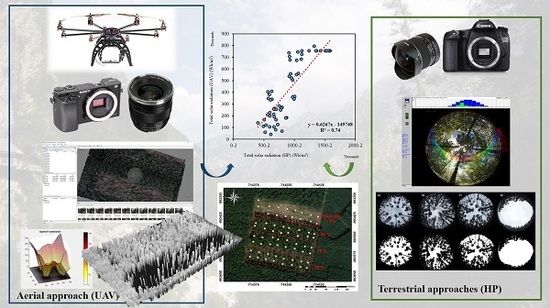UAV Capability to Detect and Interpret Solar Radiation as a Potential Replacement Method to Hemispherical Photography
Abstract
:1. Introduction
2. Materials and Methods
2.1. Characterization of the Study Area
2.1.1. Experimental Plot Design
2.1.2. Pine Regeneration Measurement
2.2. Acquisition of Data
2.2.1. Hemispheric Photography
2.2.2. Acquisition of UAV Imagery
2.3. Study Area Model Reconstruction
2.4. Solar Radiation Analysis
2.5. Statistical Analysis
3. Results
3.1. Investigation of a Correlation between HP and the UAV
3.2. Solar Radiation and Its Components Derived from HP
3.3. Solar Radiation and Its Components Derived from the UAV
4. Discussion
5. Conclusions
Supplementary Materials
Acknowledgments
Author Contributions
Conflicts of Interest
References
- Fu, P.; Richm, P.M. A geometric solar radiation model with applications in agriculture and forestry. Comput. Electron. Agric. 2002, 37, 25–35. [Google Scholar] [CrossRef]
- Fournier, R.A.; Mailly, D.; Walter, J.M.N.; Soudani, K. Indirect measurement of forest canopy structure from in situoptical sensors. In Remote Sensing of Forest Environments; Springer: New York, NY, USA, 2003; pp. 77–113. [Google Scholar]
- Peffer, K.; Pebesma, E.J.; Burrough, P.A. Mapping alpine vegetation using vegetation observation and topographic Attributes. Landsc. Ecol. 2003, 18, 759–776. [Google Scholar] [CrossRef]
- Abdollahnejad, A.; Panagiotidis, D.; Shataee Joybari, S.; Surový, P. Prediction of Dominant Forest Tree Species Using QuickBird and Environmental Data. Forests 2017, 8, 42. [Google Scholar] [CrossRef]
- Evans, G.C.; Coombe, D.E. Hemispherical and woodland canopy photography and the light climate. J. Ecol. 1959, 47, 103–113. [Google Scholar] [CrossRef]
- Anderson, M.C. Light relations of terrestrial plant communities and their measurement. Biol. Rev. 1964, 39, 425–486. [Google Scholar] [CrossRef]
- Rich, P.M. Characterizing plant canopies with hemispherical photographs. Remote Sens. Rev. 1990, 5, 13–29. [Google Scholar] [CrossRef]
- Coombe, D.E.; Evans, G.C. Hemispherical photography in studies of plants. Med. Biol. Illus. 1960, 10, 68–75. [Google Scholar] [PubMed]
- Brown, H.E.; Wordley, D.P. Some applications of the canopy camera in forestry. J. For. 1965, 63, 674–680. [Google Scholar]
- Madgwick, H.A.I.; Brumfield, G.L. The use of hemispherical photographs to assess light climate in the forest. J. Ecol. 1969, 57, 537–542. [Google Scholar] [CrossRef]
- Becker, P.; Erhart, D.W.; Smith, A.P. Analysis of forest light environments. I. Computerized estimation of solar radiation from hemispherical canopy photographs. Agric. For. Meteorol. 1989, 44, 3–4. [Google Scholar] [CrossRef]
- Chan, S.S.; McCreight, R.W.; Walstad, J.D.; Spies, T.A. Evaluating forest vegetative cover with computerized analysis of fisheye photographs. For. Sci. 1986, 32, 1085–1091. [Google Scholar]
- Chazdon, R.L.; Field, C.B. Determinants of photosynthetic capacity in six rainforest Piper species. Oecologia 1987, 73, 222–230. [Google Scholar] [CrossRef] [PubMed]
- Roxburgh, J.R.; Kelly, D. Uses and limitations of hemispherical photography for estimating forest light environments. N. Z. J. Ecol. 1995, 19, 213–217. [Google Scholar]
- Jonckheere, I.; Fleck, S.; Nackaerts, K.; Muys, B.; Coppin, P.; Weiss, M.; Baret, F. Review of methods for in situ leaf area index determination. Part I. theories, sensors and hemispherical photography. Agric. For. Meteorol. 2004, 121, 19–35. [Google Scholar] [CrossRef]
- Nebiker, S.; Annena, A.; Scherrerb, M.; Oeschc, D. A light-weight multispectral sensor for micro UAV—Opportunities for very high resolution airborne remote sensing. Int. Arch. Photogramm. Remote Sens. Spat. Inf. Sci. 2008, 37 Pt 1, 1193–1198. [Google Scholar]
- Surový, P.; Yoshimoto, A.; Panagiotidis, D. Accuracy of Reconstruction of the Tree Stem Surface Using Terrestrial Close-Range Photogrammetry. Remote Sens. 2016, 8, 123. [Google Scholar] [CrossRef]
- Mikita, T.; Janata, P.; Surový, P. Forest Stand Inventory Based on Combined Aerial and Terrestrial Close-Range Photogrammetry. Forests 2016, 7, 165. [Google Scholar] [CrossRef]
- Panagiotidis, D.; Abdollahnejad, A.; Surový, P.; Chiteculo, V. Determining tree height and crown diameter from high-resolution UAV imagery. Int. J. Remote Sens. 2017, 38, 2392–2410. [Google Scholar] [CrossRef]
- Lisein, J.; Pierrot-Deseilligny, M.; Bonnet, S.; Lejeune, P. A photogrammetric workflow for the creation of a forest canopy height model from small unmanned aerial system imagery. Forests 2013, 4, 922–944. [Google Scholar] [CrossRef]
- Grenzdörffer, G.J.; Engel, A.; Teichert, B. The photogrammetric potential of low-cost UAVs in forestry and agriculture. Int. Arch. Photogramm. Remote Sens. Spat. Inf. Sci. 2008, 37, 1207–1214. [Google Scholar]
- Westoby, M.; Brasington, J.; Glasser, N.F.; Hambrey, M.J.; Reyonds, M.J. Structure from Motion photogrammetry: A low-cost, effective tool for geoscience applications. Geomorphology 2012, 179, 300–314. [Google Scholar] [CrossRef] [Green Version]
- Mohammadi, K.; Shamshirband, S.; Tong, C.W.; Arif, M.; Petković, D.; Ch, S. A new hybrid support vector machine-wavelet transform approach for estimation of horizontal global solar radiation. Energy Convers. Manag. 2015, 92, 162–171. [Google Scholar] [CrossRef]
- Olatomiwa, L.; Mekhilef, S.; Shamshirband, S.; Petkovic, D. Adaptive neuro-fuzzy approach for solar radiation prediction in Nigeria. Renew. Sustain. Energy Rev. 2015, 51, 1784–1791. [Google Scholar] [CrossRef]
- Moghaddamnia, A.; Remesan, R.; Kashani, M.H.; Mohammadi, M.; Han, D.; Piri, J. Comparison of LLR, MLP, Elman, NNARX and ANFIS Models-with a case study in solar radiation estimation. J. Atmos. Sol. Terr. Phys. 2009, 71, 975–982. [Google Scholar] [CrossRef]
- Feng, Y.; Cui, N.; Zhang, Q.; Zhao, L.; Gong, D. Comparison of artificial intelligence and empirical models for estimation of daily diffuse solar radiation in North China Plain. Int. J. Hydrogen Energy 2017, 24, 14418–14428. [Google Scholar] [CrossRef]
- Huaiwei, S.; Gui, D.; Yan, B.; Liu, Y.; Liao, W.; Zhu, Y.; Lu, C.; Zhao, N. Assessing the potential of random forest method for estimating solar radiation using air pollution index. Energy Convers. Manag. 2016, 119, 121–129. [Google Scholar]
- Park, J.K.; Das, A.; Park, J.H. Estimating distribution of precision solar radiation using unmanned aerial vehicle. In Proceedings of the 2016 IEEE International Geoscience and Remote Sensing Symposium (IGARSS), Beijing, China, 10–15 July 2016; pp. 6718–6721. [Google Scholar]
- Hunt, E.R.; Cavigelli, M.; Daughtry, C.S.T.; McMurtrey, J.E.; Walthall, C.L. Evaluation of digital photography from model aircraft for remote sensing of crop biomass and nitrogen status. Precis. Agric. 2005, 6, 359–378. [Google Scholar] [CrossRef]
- Guillen-Climent, M.L.; Zarco-Tejada, P.J.; Berni, J.A.J.; North, P.R.J.; Villalobos, F.J. Mapping radiation interception in row-structured orchards using 3D simulation and high resolution airborne imagery acquired from a UAV. Precis. Agric. 2012, 13, 473–500. [Google Scholar] [CrossRef]
- Houborg, R.; Boegh, E. Mapping leaf chlorophyll and leaf area index using inverse and forward canopy reflectance modeling and SPOT reflectance data. Remote Sens. Environ. 2008, 112, 186–202. [Google Scholar] [CrossRef]
- Breunig, F.M.; Galvao, L.S.; Formaggio, A.R.; Epiphanio, J.C.N. Influence of dataacquisition geometry on soybean spectral response simulated by the prosail model. Eng. Agrícola 2013, 33, 176–187. [Google Scholar] [CrossRef]
- Korpela, I.; Mehtätalo, L.; Seppänen, A.; Kangas, A. Tree species identification in aerial image data using directional reflectance signatures. Silva Fenn. 2014, 48, 1080. [Google Scholar] [CrossRef]
- Kane, V.R.; Gillespie, A.R.; McGaughey, R.; Lutz, J.A.; Ceder, K.; Franklin, J.F. Interpretation and topographic compensation of conifer canopy self-shadowing. Remote Sens. Environ. 2008, 112, 3820–3832. [Google Scholar] [CrossRef]
- Demek, J. Hory a Nížiny. Zeměpisný lexikon ČSR; Academia: Praha, Czech Republic, 1987; p. 584. (In Czech) [Google Scholar]
- Strand, M.; Löfvenius, M.O.; Bergsten, U.; Lundmark, T.; Rosvall, O. Height growth of planted conifer seedlings in relation to solar radiation and position in Scots pine shelterwood. For. Ecol. Manag. 2006, 224, 258–265. [Google Scholar] [CrossRef]
- Pukkala, T.; Kuuluvainen, T.; Stenberg, P. Below-Canopy distribution of photosynthetically active radiation and its relation to seedling growth in a boreal Pinus sylvestris L., stand. Scand. J. For. Res. 1993, 1, 313–325. [Google Scholar] [CrossRef]
- El-Sebaii, A.A.; Al-Hazmi, F.S.; Al-Ghamdi, A.A.; Yaghmour, S.J. Global direct and diffuse solar radiation on horizontal and tilted surfaces in Jeddah, Saudi Arabia. Appl. Energy 2010, 87, 568–576. [Google Scholar] [CrossRef]
- Khorasanizadeh, H.; Mohammadi, K. Diffuse solar radiation on a horizontal surface: Reviewing and categorizing the empirical models. Renew. Sustain. Energy Rev. 2016, 53, 338–362. [Google Scholar] [CrossRef]
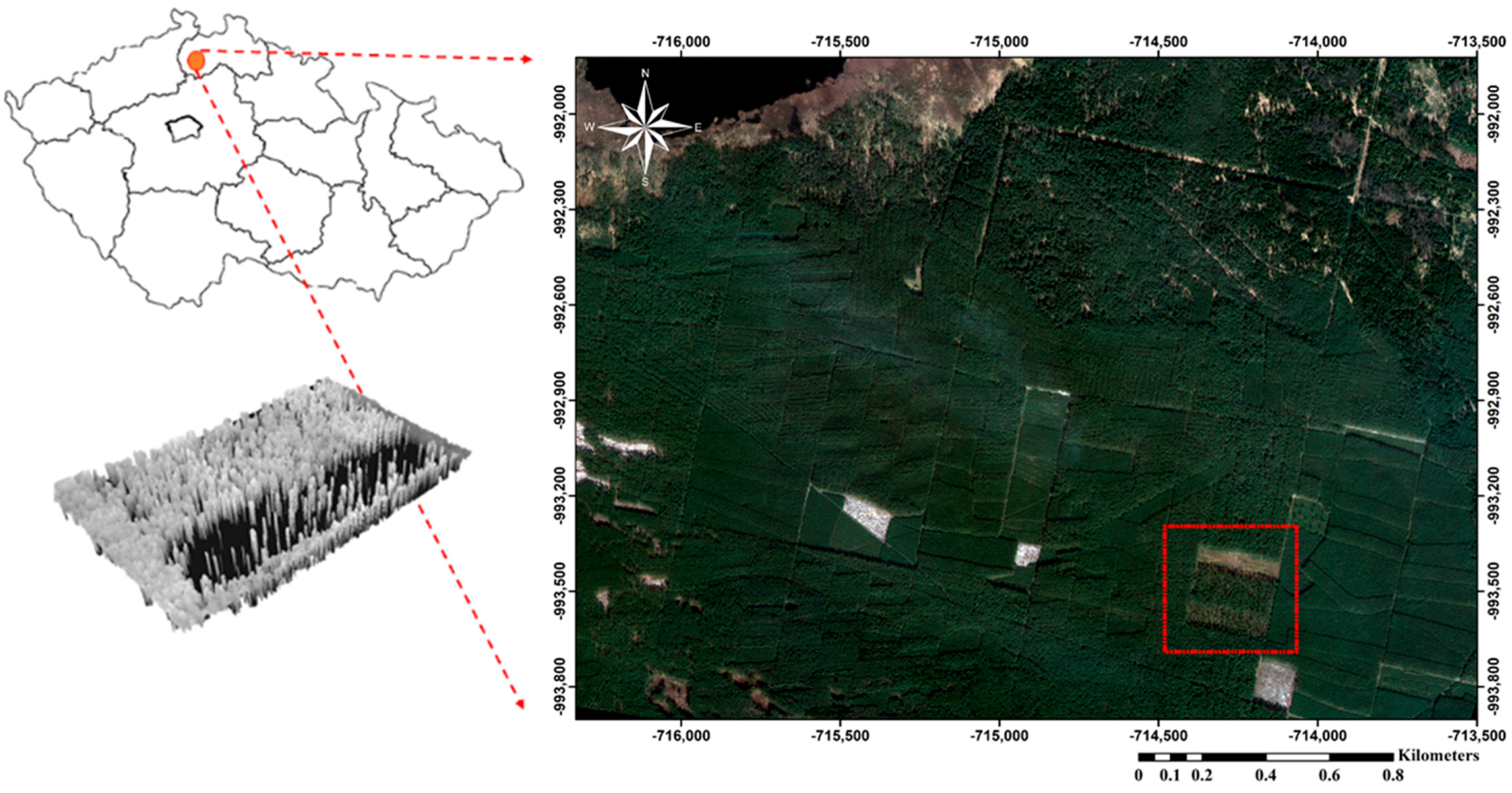
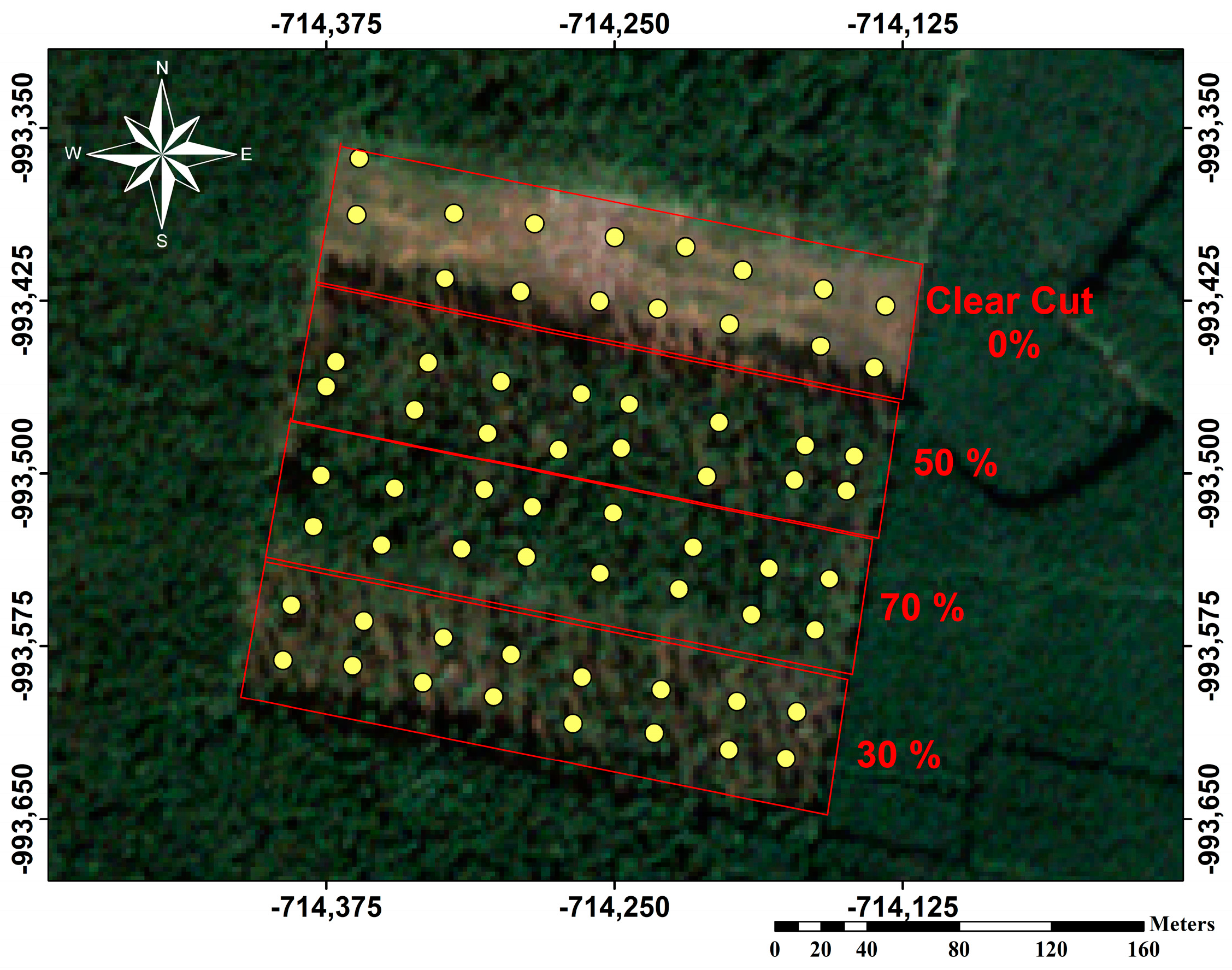
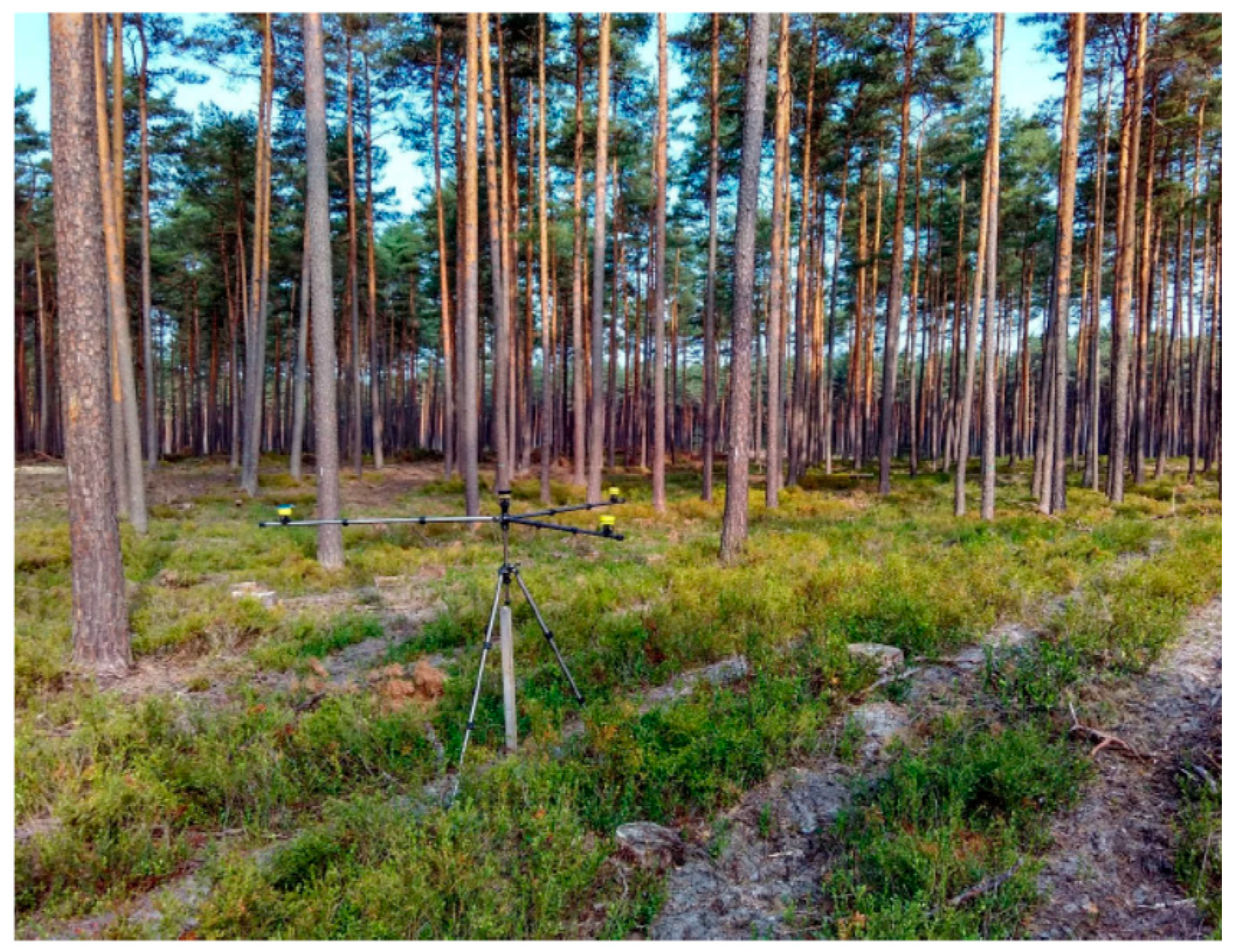
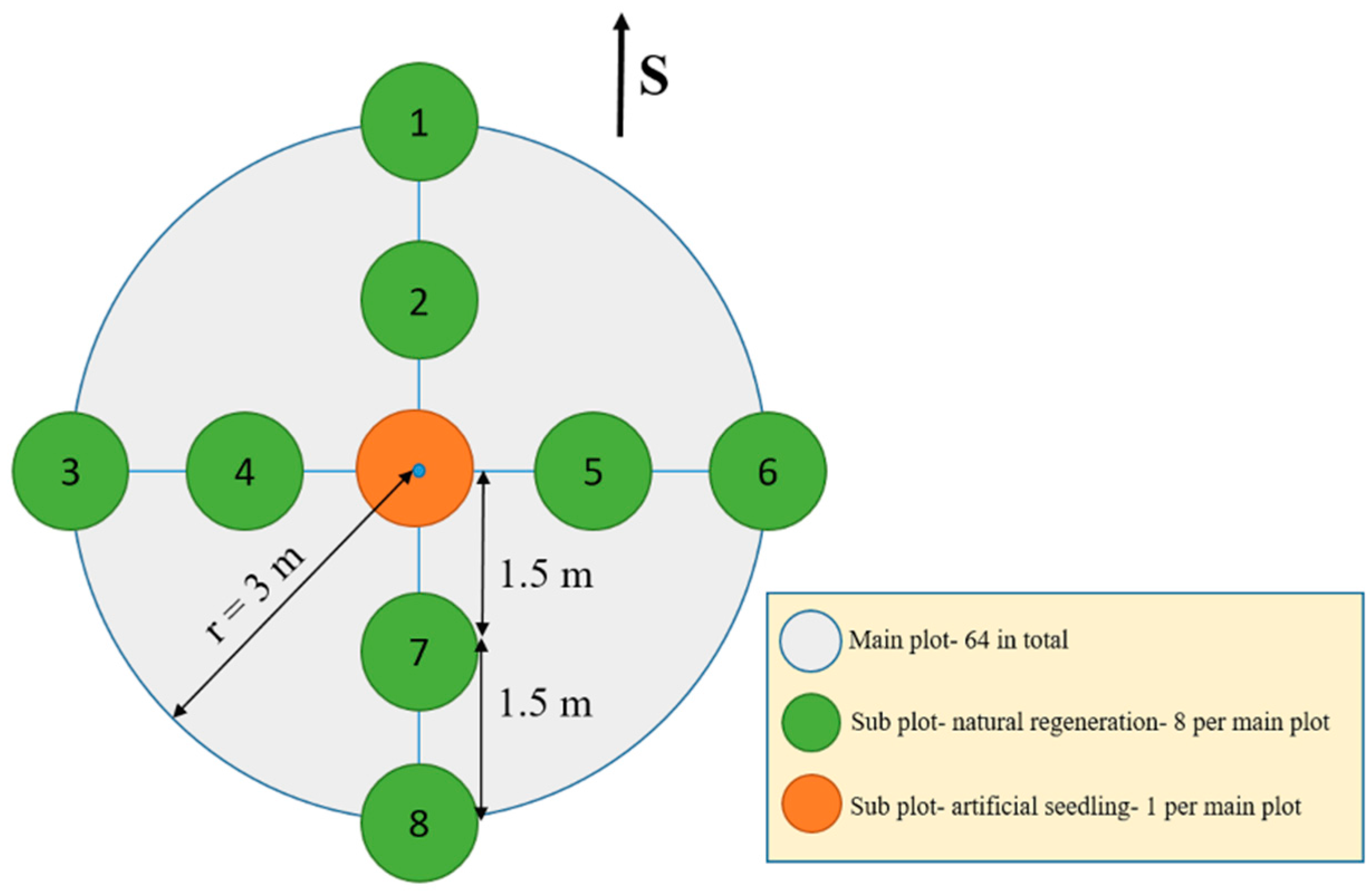
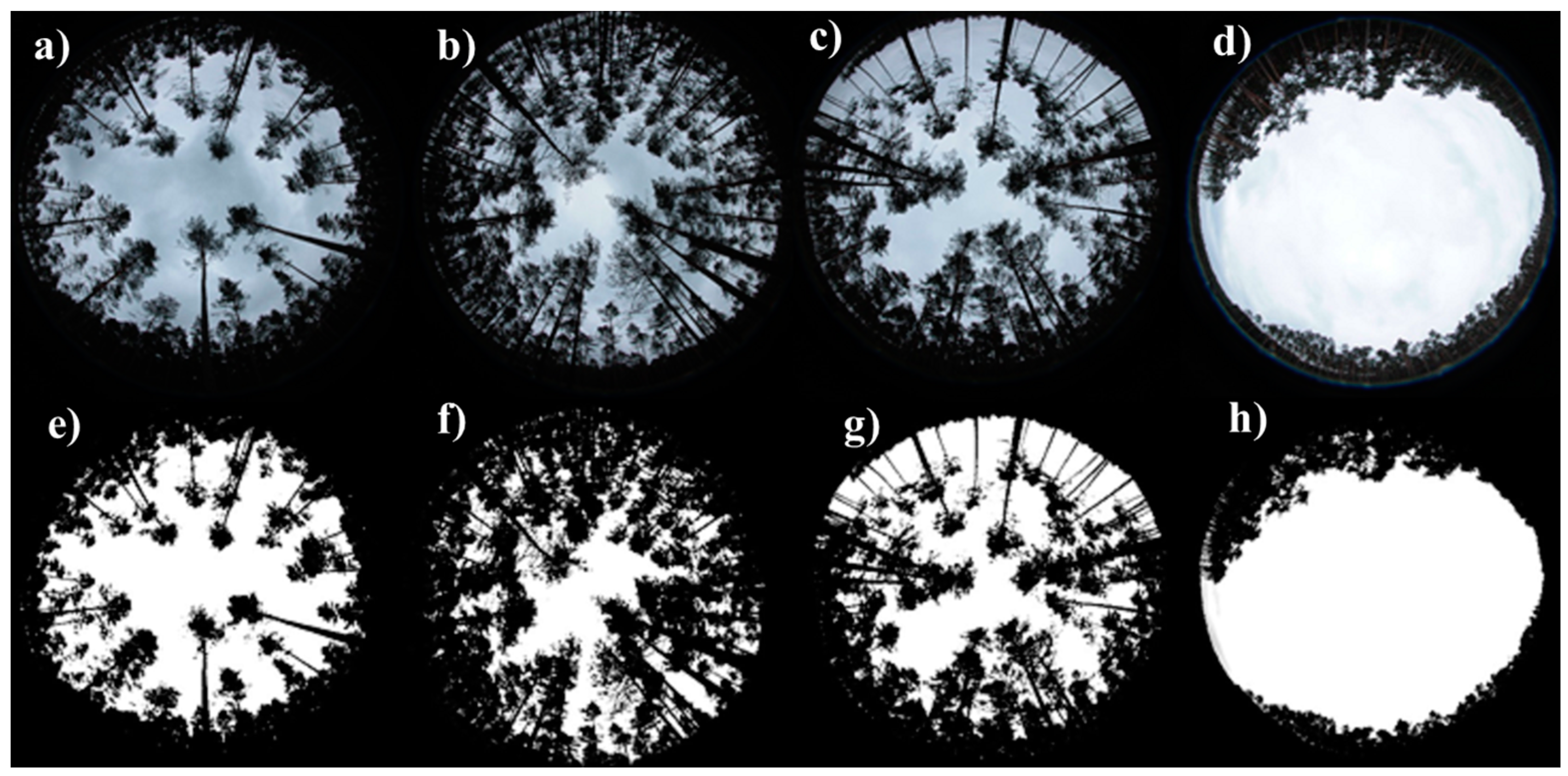
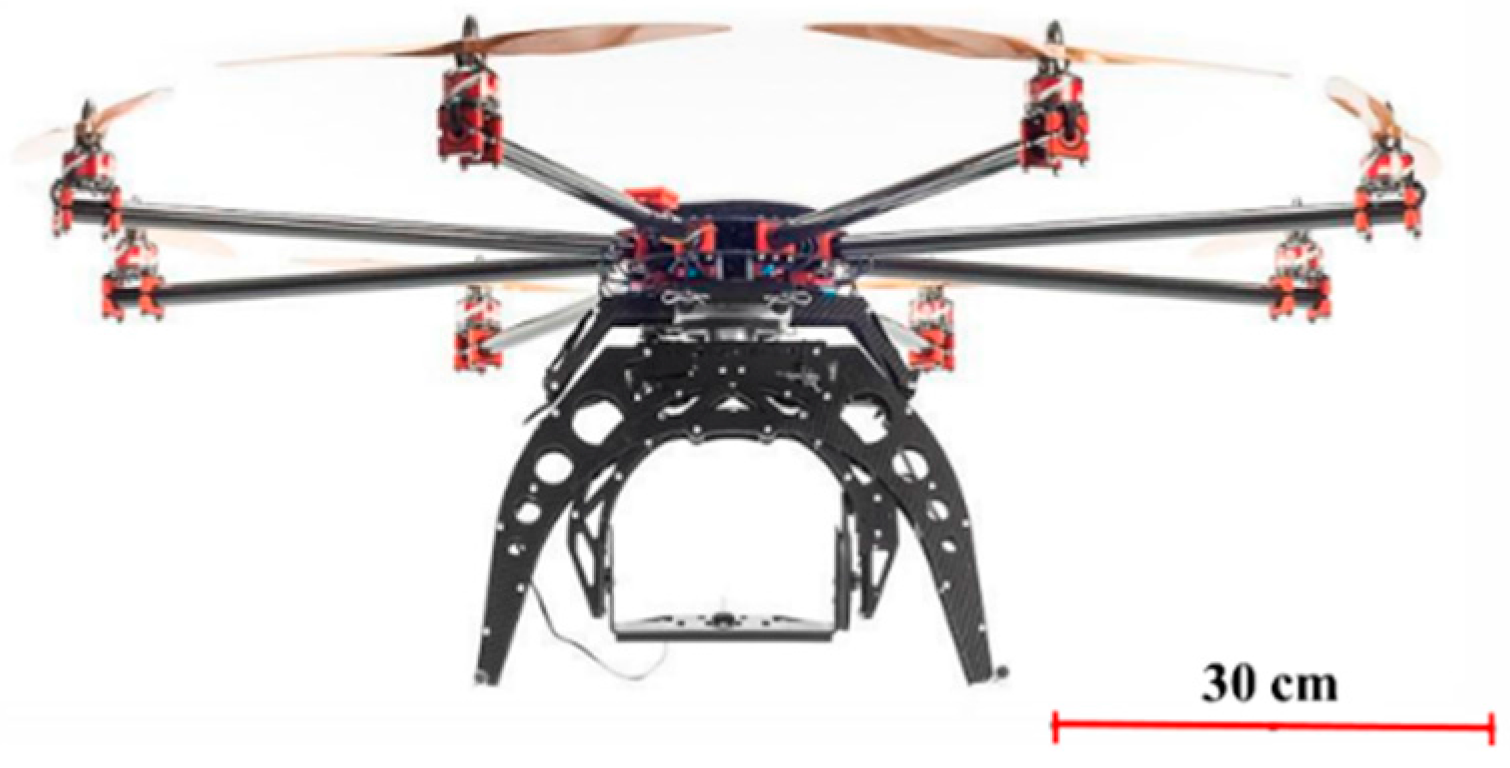
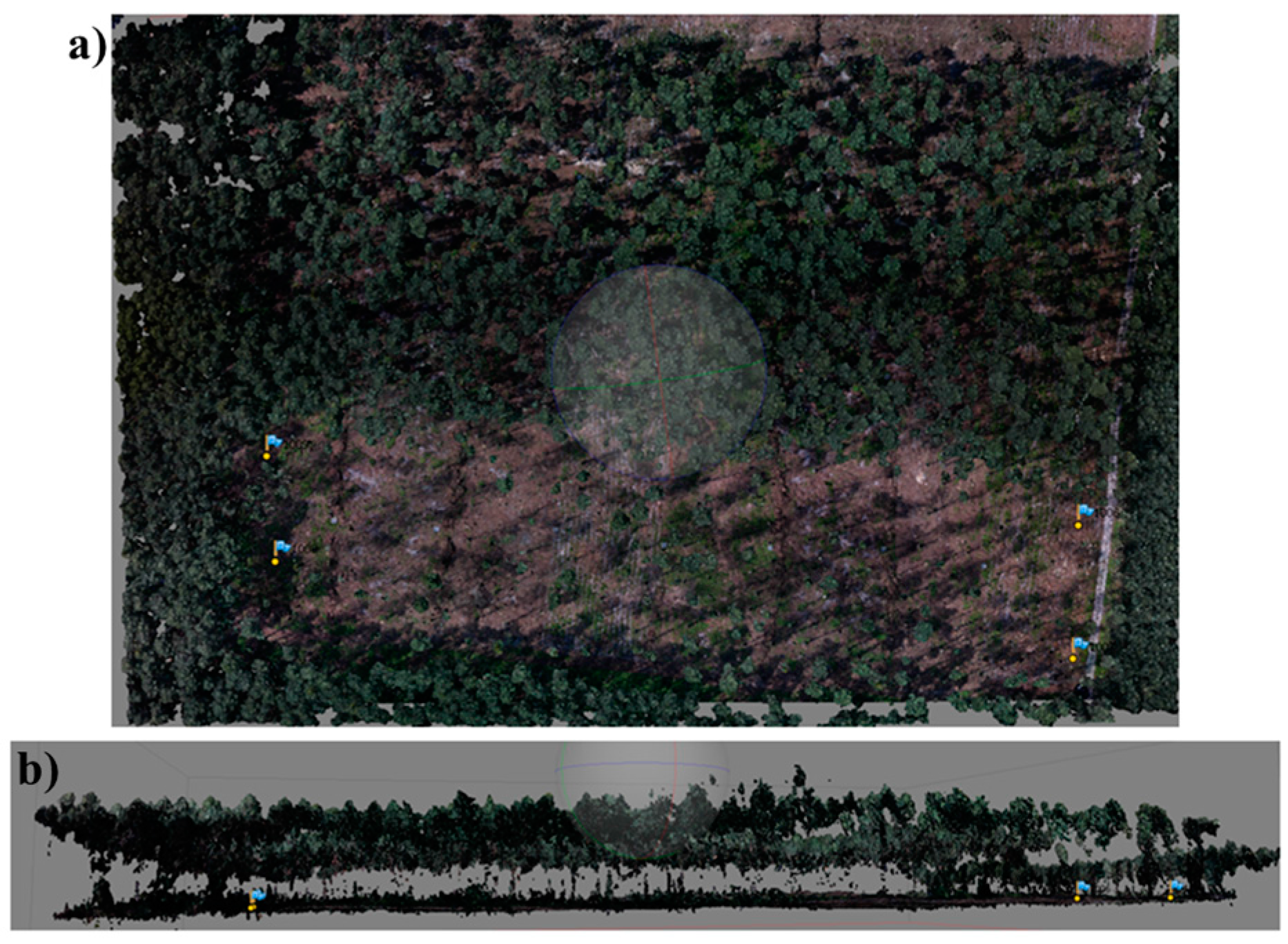
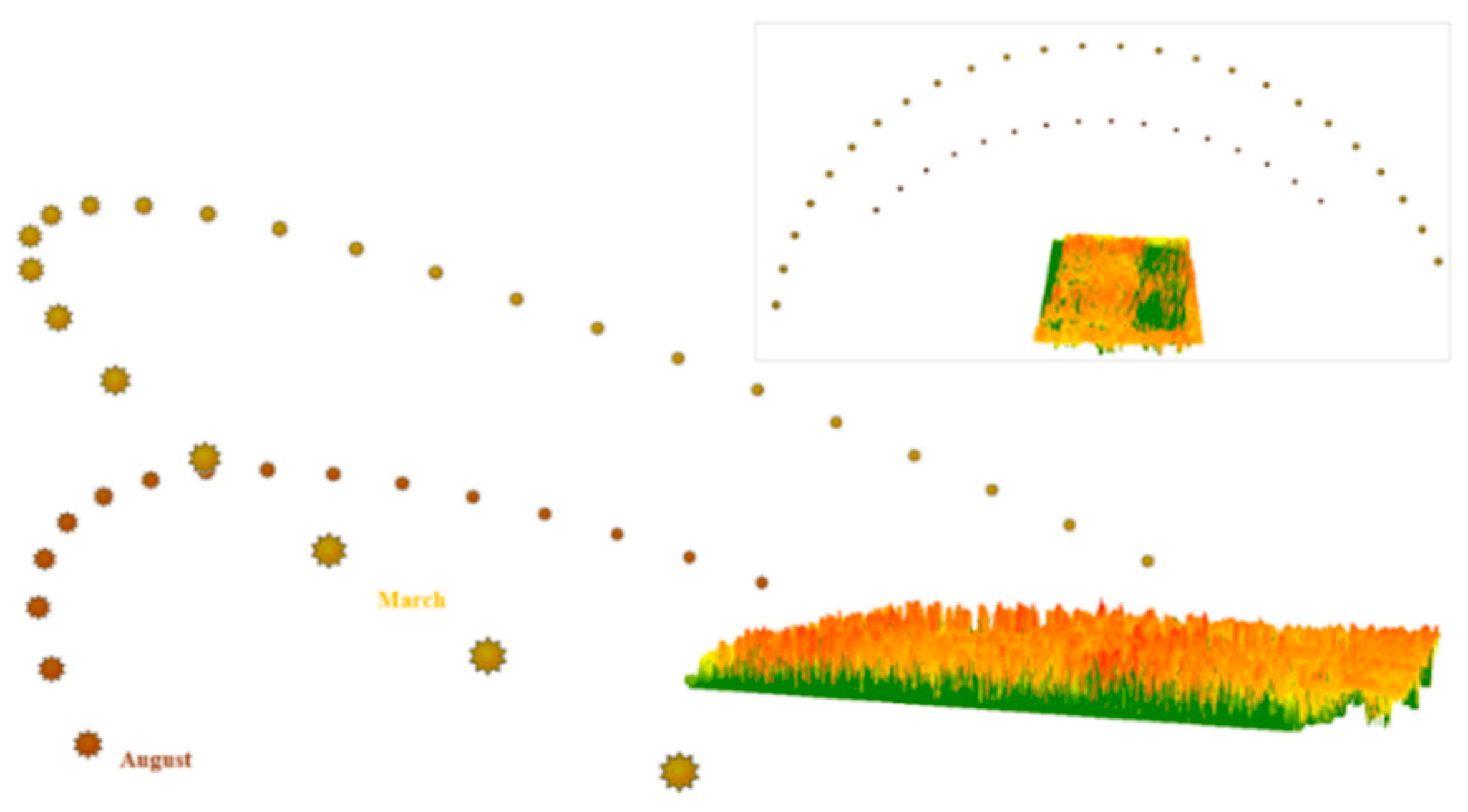
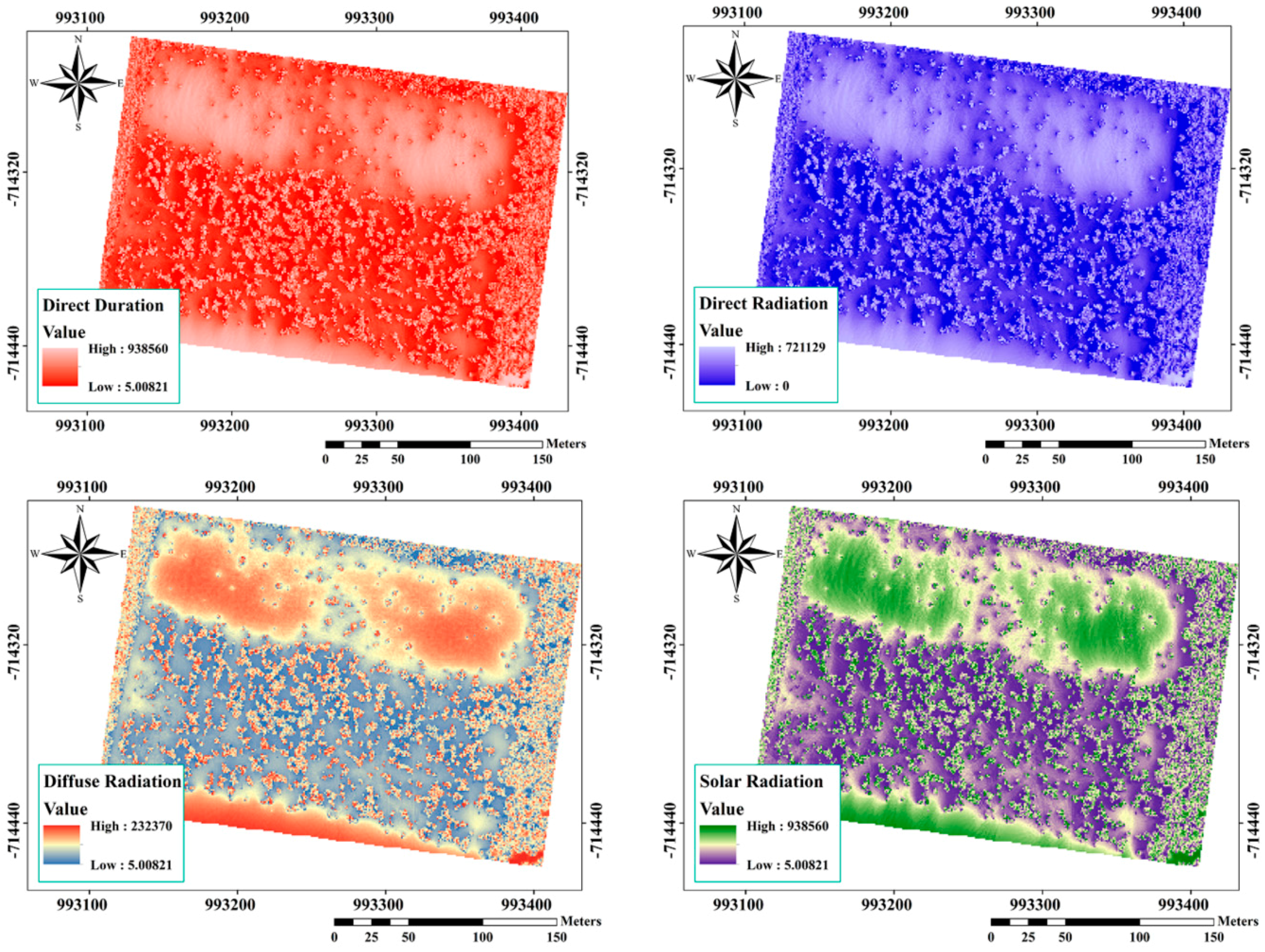

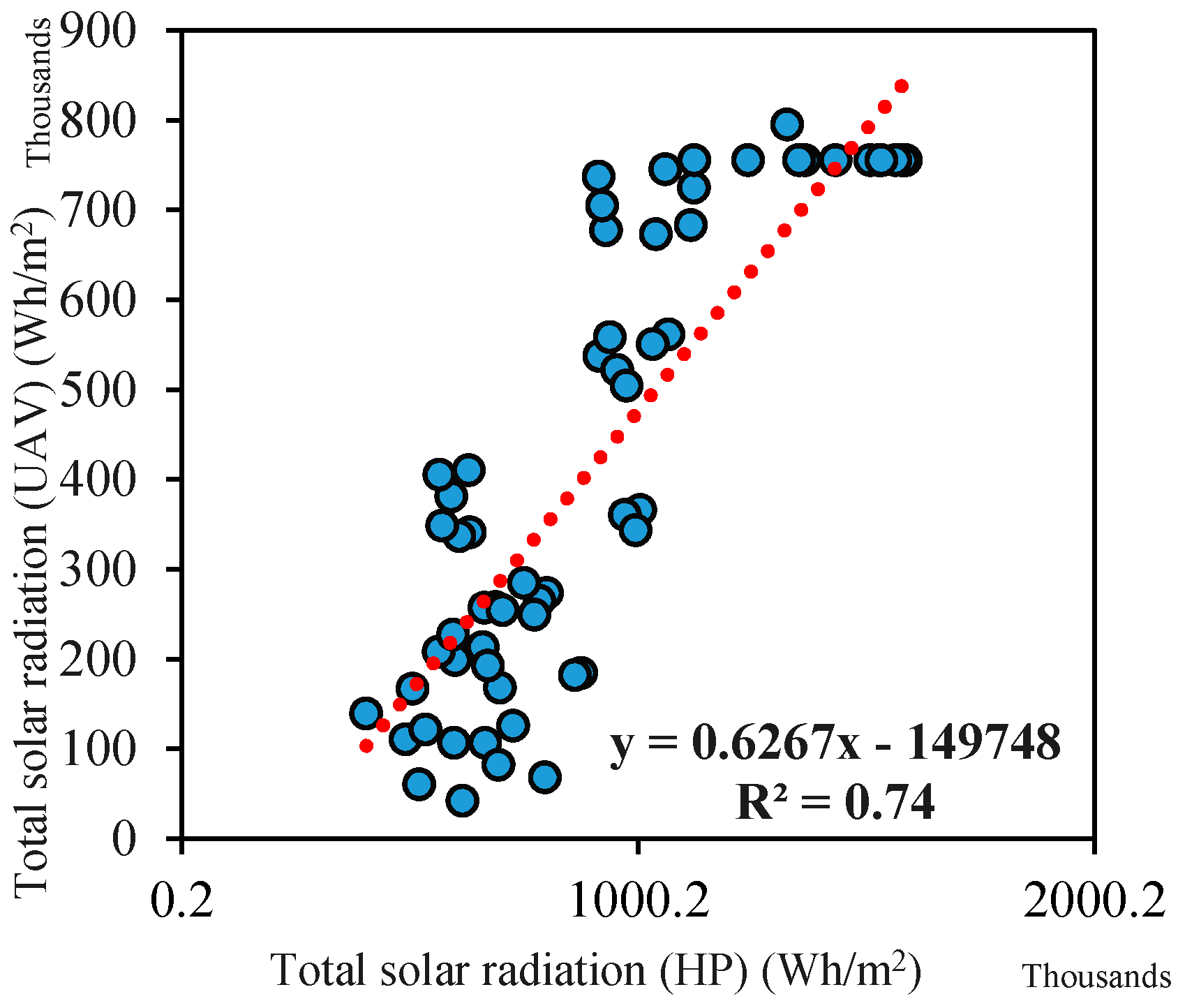

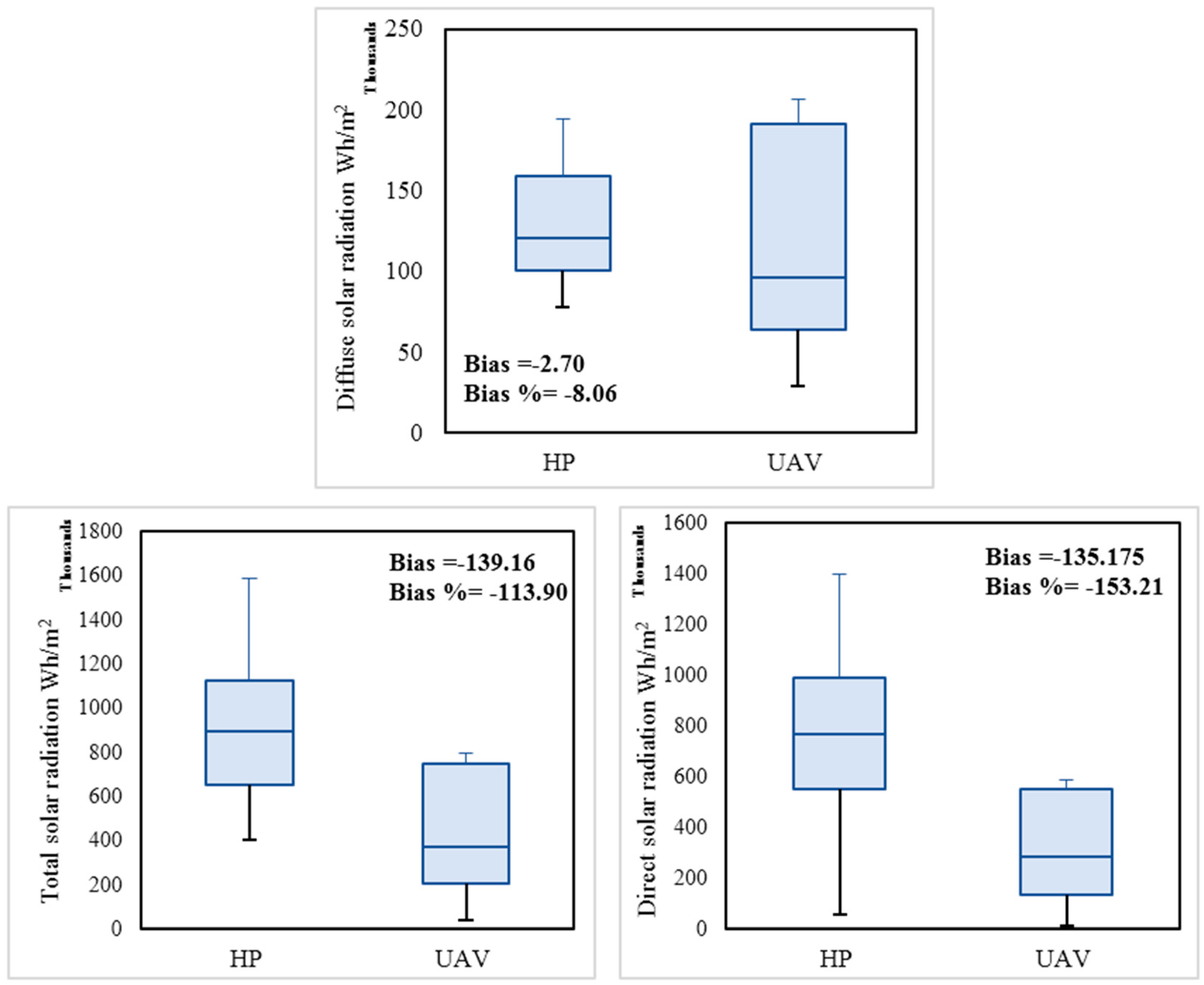
| Regression Statistics | Direct | Diffuse | Total |
|---|---|---|---|
| R | 0.96 | 0.95 | 0.96 |
| R Square | 0.92 | 0.89 | 0.93 |
| Adjusted R Square | 0.92 | 0.89 | 0.92 |
| Standard Error | 3.7 | 4.31 | 3.6 |
| sig. | 0.00 | 0.00 | 0.00 |
| df. | 63 | 63 | 63 |
| Pearson Correlation | 0.96 | 0.95 | 0.96 |
| Regression Statistics | Total Solar Radiation | Direct Solar Radiation | Diffuse Solar Radiation |
|---|---|---|---|
| Multiple R | 0.86 | 0.83 | 0.88 |
| R Square | 0.74 | 0.68 | 0.78 |
| Adjusted R Square | 0.73 | 0.68 | 0.77 |
| Standard Error | 182.41 | 186.40 | 16.98 |
| Pearson Correlation | 0.86 | 0.83 | 0.83 |
| Number of plots | 64 | 64 | 64 |
| Natural | Artificial | |||||||
|---|---|---|---|---|---|---|---|---|
| Regression Statistics | Direct | Diffuse | Total | Openness | Direct | Diffuse | Total | Openness |
| R | 0.35 | 0.37 | 0.35 | 0.38 | 0.28 | 0.30 | 0.28 | 0.30 |
| R Square | 0.12 | 0.14 | 0.13 | 0.14 | 0.08 | 0.09 | 0.08 | 0.09 |
| Adjusted R Square | 0.11 | 0.12 | 0.11 | 0.13 | 0.06 | 0.08 | 0.06 | 0.08 |
| Std error of the estimate | 8.86 | 8.80 | 8.85 | 8.80 | 7.34 | 7.28 | 7.33 | 7.28 |
| sig. | 0.00 | 0.00 | 0.00 | 0.00 | 0.02 | 0.01 | 0.02 | 0.01 |
| Pearson Correlation | −0.35 | −0.37 | −0.35 | −0.38 | −0.28 | −0.30 | −0.28 | −0.30 |
| Regeneration Type | R | R2 | Adjusted R Square | Std. Error of the Estimate | Change Statistics | ||||
|---|---|---|---|---|---|---|---|---|---|
| R2 Change | F Change | df1 | df2 | Sig. F Change | |||||
| Artificial | 0.292 a | 0.085 | 0.040 | 7.427 | 0.085 | 1.869 | 3 | 60 | 0.144 |
| Natural | 0.349 a | 0.122 | 0.078 | 9.016 | 0.122 | 2.776 | 3 | 60 | 0.049 |
| Variable | Artificial | Natural | ||
|---|---|---|---|---|
| Sig. | Coefficient | Sig. | Coefficient | |
| Diffuse radiation | 0.06 | –0.188 | 0.74 | –0.319 |
| Direct duration | 0.71 | –0.165 | 0.24 | –0.341 |
| Solar radiation | 0.08 | –0.144 | 0.04 | –0.310 |
© 2018 by the authors. Licensee MDPI, Basel, Switzerland. This article is an open access article distributed under the terms and conditions of the Creative Commons Attribution (CC BY) license (http://creativecommons.org/licenses/by/4.0/).
Share and Cite
Abdollahnejad, A.; Panagiotidis, D.; Surový, P.; Ulbrichová, I. UAV Capability to Detect and Interpret Solar Radiation as a Potential Replacement Method to Hemispherical Photography. Remote Sens. 2018, 10, 423. https://doi.org/10.3390/rs10030423
Abdollahnejad A, Panagiotidis D, Surový P, Ulbrichová I. UAV Capability to Detect and Interpret Solar Radiation as a Potential Replacement Method to Hemispherical Photography. Remote Sensing. 2018; 10(3):423. https://doi.org/10.3390/rs10030423
Chicago/Turabian StyleAbdollahnejad, Azadeh, Dimitrios Panagiotidis, Peter Surový, and Iva Ulbrichová. 2018. "UAV Capability to Detect and Interpret Solar Radiation as a Potential Replacement Method to Hemispherical Photography" Remote Sensing 10, no. 3: 423. https://doi.org/10.3390/rs10030423






